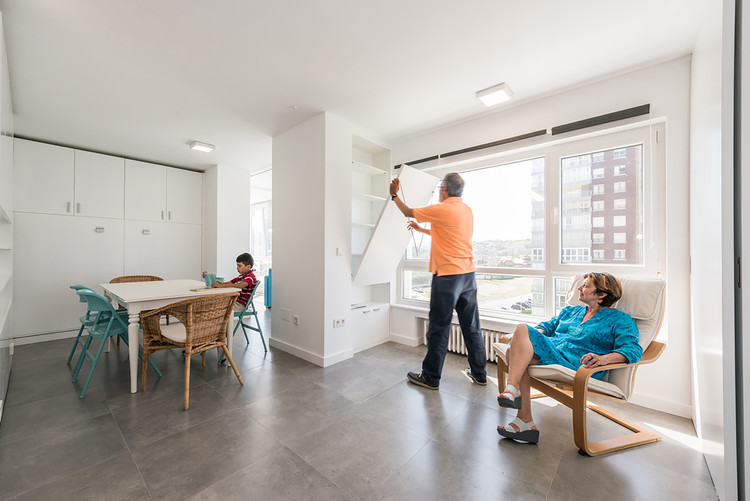
At the 2014 Venice Biennale, celebrated architect and curator Rem Koolhaas chose an unusual curatorial theme. Rather than exploring the major issues that plague modern society or their manifestations in the profession of architecture, the event's theme, "Fundamentals," and its main exhibition, "Elements of Architecture," examined in detail the bare fundamentals of buildings, simple elements used by everyday architects for everyday designs. According to Koolhaas, “Architecture is a profession trained to put things together, not to dismantle them. Only by looking at the elements of architecture under a microscope can we recognize cultural preferences, technological advances, changes triggered by the intensification of global exchange, climatic adaptations, local norms and, somewhere in the mix, the architect's ideas that constitute the practice of architecture today.”


When we approach small-scale architecture with solutions that need to be efficient for limited space, architects must include certain elements of vital importance to allow for flexibility and movement in spaces and furniture. In small apartments, the flexibility afforded by joinery solutions is especially essential, allowing each surface to serve multiple uses, such as a storage place or a door. But as omnipresent as they are in our daily lives, we generally do not give due importance to these small pieces that provide so much extra ease.

You have probably already used several hinges today without realizing it. Nowadays, the price of a hinge is so affordable that hardly any house will not have one. But this was not always the case. The popularization of hinges succeeded the evolution of manufacturing and the popularization of metal parts. It is not known exactly who invented the door hinge, but there are mentions of gold pieces on the doors of Solomon's Temple from as early as the Old Testament. Despite embodying an incredibly simple concept, which is to allow a part to rotate on an axis, hinges require a surprising amount of embedded technology.

Today, with the ease of using different types of wooden panels for the manufacture of joinery, there are a variety of options for closing angles, opening methods, lock use, and even child safety devices. Specifically for small spaces, solutions that allow the space to be used for multiple transformable functions are only possible with the right hinges, slides, and hardware. The bed, for example, can be a great occupier of precious space when not being used. Nowadays there are companies that manufacture beds that can easily transform into panels or small work tables. The same methods can be used to pull out a table for quick meals or to hide a sink full of dishes. On the market, there is a wide variety of solutions facilitating the movement of these doors and drawers, utilizing different materials and aesthetics to different levels of success. In general, they divide into the following groups:

Hinges
Hinges are what allow doors to pivot. For furniture, there are three main hinge mechanisms, which vary according to the covering of the edge to which it is fixed:
- Full overlay: Completely cover, in most cases, the edge of the side of the furniture.
- Half overlay: Cover partially. This allows, for example, for two doors to meet on the same cabinet.
- Insert embed: This type allows the doors to face the cabinet.

Drawer Slides
The most common drawer slides today are so-called telescopic slides, which hold up to about 45 kg in weight. They consist of steel ball bearings on a small rail, allowing the drawer to open fully, almost always with a safety lock so that it does not fall. They can be visible or hidden.

Sliding Doors
Sliding doors can be a great asset when space is limited. There are essentially two main parts to a sliding door: the rolling fittings and a rail through which the door will run. There are several options for finishing and design on the market, with visible and hidden options.

Articulators and Pistons
These fittings allow the door to be tilted open, which can be useful for taller chests or cabinets or in low niches where a drawer is not desired. They usually work together with a hinge, as a reinforcement. Therefore, it is very important that they contain a lock so that they are not a nuisance when accessing the space.

Steel, aluminum, and stainless steel are the most common materials for hardware. As much as the decision about these small pieces in furniture is usually relegated to manufacturers and suppliers, it is useful for architects to be aware of the possibilities and thus to choose these pieces properly, though they are typically only considered once when they stop working. It is worth adapting the project to the catalogs of the chosen manufacturer and to always pay attention to the maximum load that a part can bear. It is also always prudent to seek supplier companies with experience and quality guarantees. Other than that, creativity can “run wild.”

This article is part of the ArchDaily Topic: Tiny. Every month we explore a topic in-depth through articles, interviews, news, and projects. Learn more about our monthly topics here. As always, at ArchDaily we welcome the contributions of our readers; if you want to submit an article or project, contact us.


